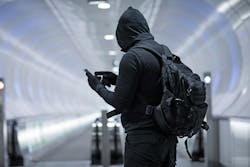The Dissection of a Domestic Terror Threat
The Trump Tower Tesla explosion in Las Vegas, the New Orleans New Year’s Day attack, and the public shooting of a prominent healthcare CEO are just three examples of a disturbing evolution in domestic and corporate terrorism.
Civil unrest, political polarization, and wealth inequality, among other factors, amplify threat actors' grievances, which they lash out in increasingly destructive ways. Rapidly diversifying methods of disruption and propaganda dissemination highlight the necessity of preparing private and public sector organizations before the threat accelerates out of control.
SecurityInfoWatch (SIW) Editorial Director Steve Lasky spoke with Mark Freedman, CEO of Rebel Global Security, to discuss the rise of domestic terror threats in the United States.
(Note: This executive Q&A was edited for clarity and length. Listen to the original conversation on the SecurityDNA podcast here.)
SIW: How is the evolving global network of jihadists influencing the radicalization and operational capabilities of domestic actors in the U.S.?
Freedman: The New Orleans New Year’s Day attack is a good starting point because it has all the hallmarks of the ISIS-inspired attacks in the mid-2010s. The attacker, Shamsud-Din Jabbar, was an American citizen who was radicalized remotely. He had no direct contact with ISIS operatives; he was just an individual who ingested radicalizing propaganda.
A confluence of factors—mental health, financial stressors, and interpersonal relationship stressors—comes into play. The “terrorist” angle then becomes an activator or catalyst that gives them purpose or meaning. This culminates in destruction.
There aren’t a lot of new developments in the jihadist threat environment. Their tactics, techniques, and procedures haven’t changed much; vehicle ramming, for example, was popular with jihad-inspired assailants in the mid-2010s.
That’s not to say nothing is evolving in that sphere. The October 7th attacks by Hamas in Israel and the fallout from those attacks shifted the paradigm.
SIW: Has social media shifted this paradigm, and is there anything law enforcement can do to halt radicalization proactively?
Freedman: Throughout history, conflicts like those in Iraq, Afghanistan, and Syria have had a catalyzing effect when it comes to jihadist terrorism. People who may not have been radicalized otherwise see stories on the news or content on social media that upset them, and when those emotions coalesce with other personal stressors they have, it becomes more likely that they’ll get sucked down a propaganda rabbit hole.
This self-radicalization is particularly dangerous because it’s difficult for law enforcement to monitor. Someone might get sloppy and leave evidence if communication with another party is involved. This “lone wolf terrorism” is more complicated to capture proactively.
Social media is a fundamental factor in exacerbating existing tensions. As people increasingly move out of physical spaces and into virtual spaces, what goes into their minds is determined by an algorithm instead of experiences in their environment. It has become highly conducive to developing conspiracy theories and conspiratorial views.
SIW: There has been a spike in right-wing and Christian nationalist terrorism in the U.S.—are there any political factors driving this?
Freedman: We’re in an interesting political environment wherein it is tough to disentangle all the causal factors at play.
From a textbook perspective, spikes in terrorism correlate with the shutting down of legitimate pathways to political expression. However, that needs to be balanced against the emboldening effect that mainstream right-wing populism is having on some right-wing extremists.
When Donald Trump lost the presidential election in 2020, protestors gathered at the Capitol on January 6th. When their political expression was shut down, violence broke out. The marching on of progressive, liberal values inspired an existential dread amongst the hardline groups in attendance that catalyzed their response.
From a textbook perspective, spikes in terrorism correlate with the shutting down of legitimate pathways to political expression. However, that needs to be balanced against the emboldening effect that mainstream right-wing populism is having on some right-wing extremists.
- Mark Freedman, CEO of Rebel Security
Placing Trump’s personal views and motives aside, some right-wing extremists see an ally in him, which can embolden aggressive behavior. Social media networks have advocated for, inspired, and facilitated far-right terrorism around the world. Discussion has become highly politicized, but mitigating right-wing terrorism should be a bipartisan priority.
SIW: Fringe left-wing elements are also beginning to cause significant unrest, with the latest being the assassination of UnitedHealthcare CEO Brian Thompson. Why is left-wing domestic terrorism more challenging to predict?
Freedman: Of course, terrorism doesn’t belong exclusively to the right wing. Far-left terrorism in the United States and elsewhere is on the rise, which is concerning for several reasons.
The main reason is that the public, the government, and our counterterrorism authorities have their minds wrapped around jihadist and right-wing threats. We have recent historical reference points for right-wing terror, like the January 6th Capitol attack, but we have also been dealing with similar incidents since the 1995 Oklahoma City bombings. There’s a well-trodden path for understanding the contours of the threat.
When it comes to left-wing terrorism, there isn’t much historical precedent—you need to look back through the early 20th century. The Earth Liberation Front (ELF) and Animal Liberation Front (ALF) were primarily involved in arson and property destruction and consciously avoided causing any human casualties. The ideologies and political views associated with the left, like gun control, are also associated with nonviolence. When the left gets riled up, we expect property destruction and vandalism but not the intent to kill. The murder of UnitedHealthcare CEO Brian Thompson is emblematic of a boiling over of extreme far-left views into violence.
SIW: Is today’s tense political climate to blame for emboldening people to not only speak openly in defense of domestic terrorism but to commit acts themselves?
Freedman: The widespread reaction to Luigi Mangione has been concerning. People across both sides of the aisle on social media have been condoning his assassination of Brian Thompson.
I’ve seen individuals who protest in favor of Luigi Mangione also walk around with Hamas flags, so there is some crossover between these causes. Some of these symbols appear at multiple associated rallies. There are a few things concerning that; sympathy for designated foreign terrorist organizations is first and foremost.
On a deeper level, the ignorance of these alliances is worrisome. Hamas, for example, is aligned with the extremely conservative right—they don’t share any sympathies with any left-wing causes in the United States. Black-and-white thinking is dangerous because it means that the ability to learn and understand has gone out the window. Individuals going down the path of radicalization have already bought into this black-and-white worldview, which is pushed further by their own personal stressors.
The political environment we’re in now is highly charged on both sides. Social media algorithms push tailored radical content, and individuals are unwilling or unable to meet in the middle of the aisle. Concerning statements are being made across the board; for example, the message spread by the Democratic presidential campaign that Trump was a threat to democracy. This message gets sent out into the ether and can end up anywhere, from social media to the journaling of an assassin.
Whether the messaging is correct or not, it can spur individuals to action. In a political environment where anything goes, someone might feel they have the license to take the law into their own hands.
SIW: What strategies can law enforcement, intelligence agencies, and other parties use to mitigate the domestic terror threat proactively? Are there any effective interventions to counter its spread?
Freedman: Deradicalization is difficult work. Whether they are going down the road to radicalization or have already engaged in terrorist activity, they are stuck in their black-and-white worldview. Social media has made it easier for organizations like Hamas to disseminate their propaganda to an overseas audience.
Social media must be taken seriously as a major contributor to political radicalization. There hasn’t been any meaningful legislation to regulate sensitive content. Laws and regulations of all stripes are in place in the financial services sector to address terrorist financing and money laundering; even though it causes a major headache for banks, these restrictions aren’t a priority for social media companies. Pushes need to be made in government for proactive legislation that retains personal privacy.
Combating the political tension that enables radicalization means abandoning the orthodox thinking that the left wing can’t be as prone to violence as the right. This is a rapidly shifting environment: methodologies and tactics are changing, and believing that the left will only continue to air its grievances through peaceful means is dangerous. Politics are very charged at the individual and societal level, but bipartisan cooperation is necessary. Meet in the middle and try to understand and learn from one another.

